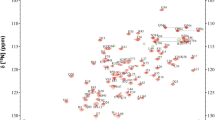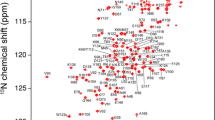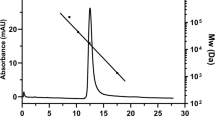Abstract
The AbrB protein is a transcription factor that regulates the expression of numerous essential genes during the cells transition phase state. AbrB from Bacillus anthracis is, nototriously, the principal protein responsible for anthrax toxin gene expression and is highly homologous to the much-studied AbrB protein from Bacillus subtilis having 85% sequence identity and the ability to regulate the same target promoters. Here we report backbone and sidechain resonance assignments and secondary structure prediction for the full-length AbrB protein from B. anthracis.
Similar content being viewed by others
Explore related subjects
Discover the latest articles, news and stories from top researchers in related subjects.Avoid common mistakes on your manuscript.
Biological context
Transition state regulator (TSR) proteins are essential for cell survival in hostile and fluctuating environments. They regulate gene expression for countless bacterial responses such as biofilm development, sporulation, toxin secretion, competence, and even complete physiological transformations (Sonenshein et al. 2002; Strauch and Hoch 1993). The transcription factor AbrB is the most widely studied TSR from a genetic and biochemical standpoint and is part of a complex and interconnected regulatory pathway in which AbrB alone has the ability to regulate the expression of more than 60 genes directly and many more due to regulation of other regulatory proteins (Bobay et al. 2004; Chumsakul et al. 2011). AbrB-like TSR’s are present in many health-related organisms, in particular, Bacillus anthracis, the Gram-positive sporulating bacterium responsible for anthrax toxin secretion. It has been shown that direct binding of AbrB to the atxA promoter is responsible for toxic gene expression in B. anthracis (Saile and Koehler 2002; Strauch et al. 2005).
From a structural viewpoint, AbrB from Bacillus subtilis is the only TSR to be characterized to any extent is (Bobay et al. 2005; Coles et al. 2005). In these studies, only the N-terminal domain of AbrB was evaluated, and analysis of the full-length protein has remained elusive. Interestingly, examination of dozens of chromosomal AbrB binding sites has failed to identify a consensus sequence that adequately explains AbrB site selection and recognition. It has been suggested that AbrB binding requires a specific three-dimensional conformation of the DNA helix (Bobay et al. 2006; Sullivan et al. 2008). Consequently, structural studies of full-length AbrB are important.
AbrB consists of 94 residues (10.5 kDa) forming a challenging homotetramer of identical subunits (Benson et al. 2002) The monomer consists of two domains with the N-terminal domain forming a looped-hinge helix fold involved in DNA binding and C-terminal multimerization domain (Bobay et al. 2005; Coles et al. 2005; Phillips and Strauch 2001). The homolog from Bacillus anthracis is nearly identical to B. subtilis with 80 out of 94 residues in the sequence the same and the first 62 residues (N-terminal domain) being identical. It was found that AbrB from both organisms can interchangeably regulate the same target promoters, even those promoters absent from their respective organism processes (Strauch et al. 2005). Their ability to regulate the same promoters and their nearly identical homology indicates very similar structures with only differentiation in the C-terminal multimerization domains. As a first step toward solving the NMR solution structure of full-length AbrB, we report nearly complete sequence specific backbone and sidechain chemical shift assignments of AbrB from B. anthracis.
Methods and experiments
Full length AbrB (residues 1–94) from B. anthracis was cloned into expression vector pET-28a (Novagen) with a Thrombin cleavable N-terminal histidine tag and transformed into BL21(DE3) cells (Genesee) for expression. To uniformly label AbrB with 13C/15N, cells were grown in 1 L of M9 media supplemented with 15NH4Cl and/or 13C-glucose at 37°C. At OD600 of~0.7 the temperature was reduced to 30°C and expression induced with 1 mM IPTG. The cells were harvested by centrifugation 4 h postinduction at 7,000×g for 15 min. Cell pellets were suspended in lysis buffer (10 mM Tris–HCl, 300 mM KCl, 1 mM DTT, 5 mM imidazole, and 0.02% sodium azide) and sonicated with resulting cell lysate clarified by centrifugation at 15,000×g and the resulting supernatant was passed over Ni–NTA agarose resin (Qiagen). The N-terminal histidine tag was removed from the purified protein by incubation with Thrombin and loaded onto a Q-Sepharose ion exchange column (GE Healthcare). Samples for NMR experiments were dialyzed into NMR buffer (10 mM KH2PO4, 15 mM KCl, 1 mM DTT, 1 mM EDTA, 0.02% sodium azide, in 10 and 100% D2O) at pH 6.0 and concentrated to 500–750 μM.
All NMR experiments were performed at 310 K on a Varian Inova 600 MHz and Bruker Avance 700 MHz, both equipped with cryoprobes. Backbone chemical shifts were assigned in a sequential manner from the following experiments: 2D [15N–1H] TROSY-HSQC, HNCO, HN(CA)CO, CBCA(CO)NH, HNCACB, and a CC(CO)NH.
Sidechain proton chemical shifts were assigned using the following experiments: HBHA(CO)NH, (H)CC(CO)NH, 15N-TOCSY (50 and 100 ms), and an HCCH-TOCSY. Aromatic assignments were made from a 13C-aromatic NOESY (100 ms). Data was processed using NMRPipe (Delaglio et al. 1995) and analyzed using Sparky (Goddard and Kneller 2006) and NMRView (Johnson and Blevins 1994). Phi/Psi dihedral angles and resulting secondary structure prediction was calculated using the program PREDITOR and protein flexibility was estimated using the Random Coil Index (RCI) (Berjanskii et al. 2006; Berjanskii and Wishart 2007).
Assignments and data deposition
Complete backbone amide assignments have been obtained for all non-proline residues 2–94 as shown in the 2D [1H–15N] TROSY-HSQC spectrum in Fig. 1. Near complete backbone resonances for Cα (98%), Cβ (99%), C′ (98%), Hα (100%) have been assigned including 96% of sidechain and 100% of aromatic proton resonances. The N-terminal (2–53) chemical shifts of the full length AbrB from B. anthracis (Fig. 1) are nearly the same to the those [1H–15N]-HSQC chemical shifts reported for the N-terminal domain of AbrB from B. subtilis indicating that these domains are identical (Bobay et al. 2005).
Chemical shift index using PREDITOR in Fig. 2a indicates a very well structured N-terminal domain (residues 2–53) with a ββαββ secondary structure-folding pattern identical to that of the published N-terminal AbrB structure from B. subtilis (Bobay et al. 2005, Coles et al. 2005). The secondary structure prediction for the C-terminal domain (residues 54–94) in Fig. 2 shows two long helices from residues 55–70 and 74–90. These two helices most likely multimerize with the C-terminus of an adjacent AbrB molecule, likely forming a bundle of four helices in forming the homotetramer. A modest increase in the Random Coil Index (Fig. 2b) in the C-terminal residues (when compared to N-terminal structured regions) indicates a rather dynamic multimerization interaction between C-terminal domains potentially necessary for AbrB’s promiscuous DNA binding (Sullivan et al. 2008). The chemical shift assignments have been deposited in the BioMagResBank (http://www.bmrb.wisc.edu) under the accession number 17650.
a Chemical shift index as determined from PREDITOR using backbone Cα, Cβ, Hα, and C′ atoms. Bar magnitudes indicate relative confidence in prediction with areas of positive values indicating extended sheet regions and negative values indicating helical secondary structure. b Random coil index indicating protein flexibility corresponding to secondary structure predicted from CSI
References
Benson LM, Vaughn JL, Strauch MA, Bobay BG, Thompson R, Naylor S et al (2002) Macromolecular assembly of the transition state regulator AbrB in its unbound and complexed states probed by microelectrospray ionization mass spectrometry. Anal Biochem 306(2):222–227
Berjanskii MV, Wishart DS (2007) The RCI server: rapid and accurate calculation of protein flexibility using chemical shifts. Nucleic Acids Res 35(2):W531–W537
Berjanskii MV, Neal S, Wishart DS (2006) PREDITOR: a web server for predicting protein torsion angle restraints. Nucleic Acids Res 34(2):W63–W69
Bobay BG, Benson L, Naylor S, Feeney B, Clark AC, Goshe MB et al (2004) Evaluation of the DNA binding tendencies of the transition state regulator AbrB. Biochem (NY) 43(51):16106–16118
Bobay BG, Andreeva A, Mueller GA, Cavanagh J, Murzin AG (2005) Revised structure of the AbrB N-terminal domain unifies a diverse superfamily of putative DNA-binding proteins. FEBS Lett 579(25):5669–5674
Bobay BG, Mueller GA, Thompson RJ, Murzin AG, Venters RA, Strauch MA et al (2006) NMR structure of AbhN and comparison with AbrBN: first insights into the DNA binding promiscuity and specificity of AbrB-like transition state regulator proteins. J Biol Chem 281:21399–21409
Chumsakul O, Takahashi H, Oshima T, Hishimoto T, Kanaya S, Ogasawara N et al (2011) Genome-wide binding profiles of the Bacillus subtilis transition state regulator AbrB and its homolog Abh reveals their interactive role in transcriptional regulation. Nucleic Acids Res 39(2):414–428
Coles M, Djuranovic S, Söding J, Frickey T, Koretke K, Truffault V et al (2005) AbrB-like transcription factors assume a swapped hairpin fold that is evolutionarily related to double-psi β barrels. Structure 13(6):919–928
Delaglio F, Grzesiek S, Vuister GW, Zhu G, Pfeifer J, Bax A (1995) NMRPipe: a multidimensional spectral processing system based on UNIX pipes. J Biomol NMR 6(3):277–293
Goddard TD, Kneller DG (2006) Sparky 3. University of California, San Francisco
Johnson BA, Blevins RA (1994) NMR view: a computer program for the visualization and analysis of NMR data. J Biomol NMR 4(5):603–614
Phillips ZEV, Strauch MA (2001) Role of Cys54 in AbrB multimerization and DNA-binding activity. FEMS Microbiol Lett 203(2):207–210
Saile E, Koehler TM (2002) Control of anthrax toxin gene expression by the transition state regulator AbrB. J Bacteriol 184:370–380
Sonenshein AL, Hoch JA, Losick R (2002) Bacillus subtilis and its closest relatives: from genes to cells. ASM Press, Washington DC
Strauch MA, Hoch JA (1993) Transition-state regulators: sentinels of Bacillus subtilis post-exponential gene expression. Mol Microbiol 7(3):337–342
Strauch MA, Ballar P, Rowshan AJ, Zoller KL (2005) The DNA-binding specificity of the Bacillus anthracis AbrB protein. Microbiology 151(6):1751–1759
Sullivan DM, Bobay BG, Kojetin DJ, Thompson RJ, Rance M, Strauch MA et al (2008) Insights into the nature of DNA binding of AbrB-like transcription factors. Structure 16(11):1702–1713
Acknowledgments
This work is supported by a NIH grant (GM55769) and Department of Defense grant (DM090298) to JC and CM.
Author information
Authors and Affiliations
Corresponding author
Rights and permissions
About this article
Cite this article
Olson, A.L., Bobay, B.G., Melander, C. et al. 1H, 13C, and 15N resonance assignments and secondary structure prediction of the full-length transition state regulator AbrB from Bacillus anthracis . Biomol NMR Assign 6, 95–98 (2012). https://doi.org/10.1007/s12104-011-9333-2
Received:
Accepted:
Published:
Issue Date:
DOI: https://doi.org/10.1007/s12104-011-9333-2






